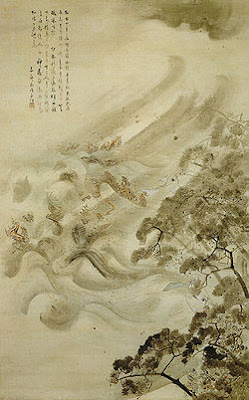Kamikaze doesn't exactly mean suicide airplanes. Kamikaze means "Divine Wind."
This short but excellent explanation of the origin of Kamikaze from Shmoop:
By the late thirteenth century, the Mongol Empire stretched from Korea to Eastern Europe, making it the largest contiguous empire the world has ever seen. In fact, Mongols are the only people in history ever to have successfully pulled off a winter invasion of Russia. Basically, these guys are the rockstars of the military world.
So when it came time to invade Japan, only two things could stop them:
1) A typhoon
2) Another typhoon
The Mongol fleet destroyed in a typhoon, ink and water on paper, by Kikuchi Yōsai, 1847
In November of 1274, Kublai Khan sent a fleet of an estimated 600 ships into Hakata Bay. They were devastated by a typhoon after only one day of fighting. Dismayed but not defeated, Kublai Khan spent the next seven years regrouping for a bigger, stronger attack.
In August of 1281, the Mongols sent an estimated 900 ships into Hakata Bay – only to be destroyed by a second, much larger typhoon. Just to be clear, although typhoons are common in Japan, the first one happened well after typhoon season and the second was a kind that’s estimated to occur only once every few hundred years.
Convinced of a divine intervention, the Japanese called the two storms “kamikaze,” or divine winds. Kublai Khan was inclined to agree: the Mongols never tried to invade Japan again.
See more about the Top 7 Epic Fails in Human History at Schmoop.



No comments:
Post a Comment